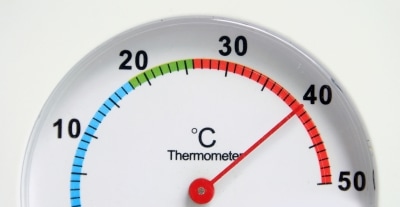Here’s an example. Spring Break just occurred. Did you go hit a tropical beach somewhere? If the beach was hotter and more humid than back home, you probably felt like you were baking in the sun. I went to Costa Rica with my family. It was in the low-80s, but it felt so much hotter because it had been in the 50s back in Boulder. But, come Summer, the low-80s will be pretty comfortable. I also recall feeling a bit “thick” and lethargic the first few days there as my body fought to acclimate. Now, think about having to race in that very same heat and humidity a few days after your arrival. Many of us from Northern climates are unprepared for the heat at popular early-season IRONMAN events in either subtropical or even Central European regions. Heat is a determining factor that impacts both training and racing, but it is also one you can account for and proactively address.
Some people acclimate very easily to the heat (or, conversely, to the cold). Most of us do not. Quite a bit of this has to do with genealogy and physiology, yet can still be influenced. Heat not only impairs performance, but it could lead to complications, such as heat exhaustion or, worse, heat stroke. In any race, you’ll swim when it’s cooler and the water will also provide a cooling effect. But, as your races progress, especially 70.3 and 140.6 distances, you will eventually reach the point where you feel like you’re baking in the oven as both temperatures and humidity rise throughout the day.
Why is dealing with the heat important? The body is actually pretty inefficient at dissipating heat. In order to lower your core body temperature, blood is pulled to the surface (this is why your skin turns beet red). Yet, with less blood available for the working muscles, your heart has to pump harder in order to provide the muscles with the O2 they need to perform. Which in turn raises your core temp further. It can become a nasty feedback loop. It takes a lot of energy to cool the body down, so you will be burning through your energy stores at an accelerated rate.
With higher heart rate, you will also experience an increase in blood lactate concentration. Couple this with dehydration and you will have even lower blood volume available and your blood will also be thicker and, thus, harder for the heart to pump. So, there are two options: 1) slow down in order to keep your HR in check; or 2) increase your HR in order to maintain your current output. It’s a fine line, and one that needs to constantly be monitored to avoid heat-related maladies.
Acclimating to the heat improves the body’s ability to exercise in higher temperatures. For most endurance athletes, training for key events starts early in the year, in the cool Fall or dead of Winter cold. This does not simulate anything close to race day conditions. For example, I did a climbing ride that gained about 8,000ft of vertical. I did this ride twice in the Winter when the temps peaked in the 50s and the rides went great. On this more recent occasion, the temps peaked in the mid-70s and it was my first ride “in the heat” of the Spring. The ride started out fantastic; really strong. But, let’s just say that the back half was a complete and utter death march. As the day heated up, so did my body and my performance shut down. Ugh.
With that in mind, here are a couple training strategies to consider:
- Extra Layers. You can force heat simulation by adding an extra layer or two of clothing during training. One example is wearing a trash bag underneath your cycling jersey, or wearing tights and turtleneck during a run. If you shoot for about 10 training sessions over the course of 2-3 weeks, you will force the body to become more efficient at dissipating heat. The first few sessions will probably be pretty darn uncomfortable, so start with shorter, less intense workouts before graduating up to more intense or longer ones. And be sure to maximize your rehydration strategy both directly after these workouts as well as throughout the rest of the day.
- Artificial Heat. Another way to acclimate to the heat is to artificially increase the ambient temperature around you. One example of this is spending time in a sauna or steam room. Another is driving with the windows up and heater blasting when you would rather have the windows down. This approach raises your core body temperature, which will allow for greater heat adaptation. Rather than do this in tandem with the approach of training with more layers on, instead incorporate these heat sessions in the closing several weeks before your key race. Start with 10-15 minutes per session and gradually increase to 20-30 minutes. 3-4 times per week is plenty.
At the end of this, you should both feel more comfortable in the heat and be able to perform better in it. Specifically, here are the benefits you will come to experience:
- Increased blood flow to muscles, heart and skin
- Improvements in fluid balance and cardiovascular stability
- Enhanced sweat capacity
- Less glycogen use
- Lower HR at the same perceived effort and, thus, lower lactate buildup
Ideally, you will want to start your heat acclimation 3-4 weeks before your key event in the heat, and then stop it the final 7-10 days. You will be adding some big stressors to your routine that will drain you to a greater degree than to which you’re accustomed. Backing off in the final week-plus will allow your body and energy to bounce back but without devaluing the acclimation you just realized.
Follow this advice and you will toe the line with greater confidence and the ability to perform at a higher level.
Happy Training,
Coach Nate


 RSS Feed
RSS Feed